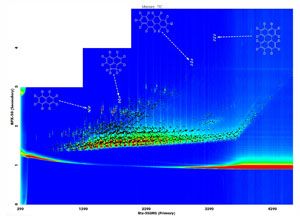ChromaTOF 4.32
ChromaTOF 4.32 is now available for all your LECO instrument systems.

ChromaTOF 4.32 is now available for all your LECO instrument systems. LECO have maintained the continuity of one software platform for all your needs whilst incorporating your wishes.
New features include Variable Modulation Times within each GC×GC chromatographic run for a truly optimised separation. This maximizes resolution in both the first and second dimensions and is compatible with both traditional LN2 and Consumable Free (CF) GC×GC systems. Also available is the LECO/Fiehn Metabolomics Library with over 1,100 spectra of 700 unique metabolomics for metabolite identification in your most complex samples. Fully integrated within ChromaTOF, the library works seamlessly with the software's Library Search function to automatically search for analyte matches without the need for importing or exporting data.
The logical database structure gives the visual benefits of seeing everything directly. Hence, all options are readily located for ease of use. Complimentary to this are the unlimited individually designed workspaces for every operator. The benefit of this flexible working style is an easy to drive acquisition and data processing software platform that can be customised to each operators preferences.
The newly implemented features are built on a history of dedication and continuous development ensuring LECO continues to provide the market leading comprehensive software package known as ChromaTOF. For more information contact the LECO Separation Science team.
Contact details
LECO European Technical Centre (ETC)
Marie-Bernays-Ring 31
41199 Mönchengladbach
Germany
Tel: +49 (0)2166 687 -104 or -107
Email: SepSci@leco.de
Web address: www.leco-etc.com
Polysorbate Analysis in Biopharmaceutical Applications — A Snapshot of the Analytical Toolbox
An overview of different approaches for the qualitative and quantitative analysis of polysorbates.
Detailed Glycosylation Analysis of Therapeutic Enzymes Utilizing Comprehensive 2D-LC–MS
January 3rd 2025In this article, the use of comprehensive two-dimensional liquid chromatography (LC×LC) coupled to mass spectrometry (MS) for characterizing glycosylation of therapeutic enzymes is presented.